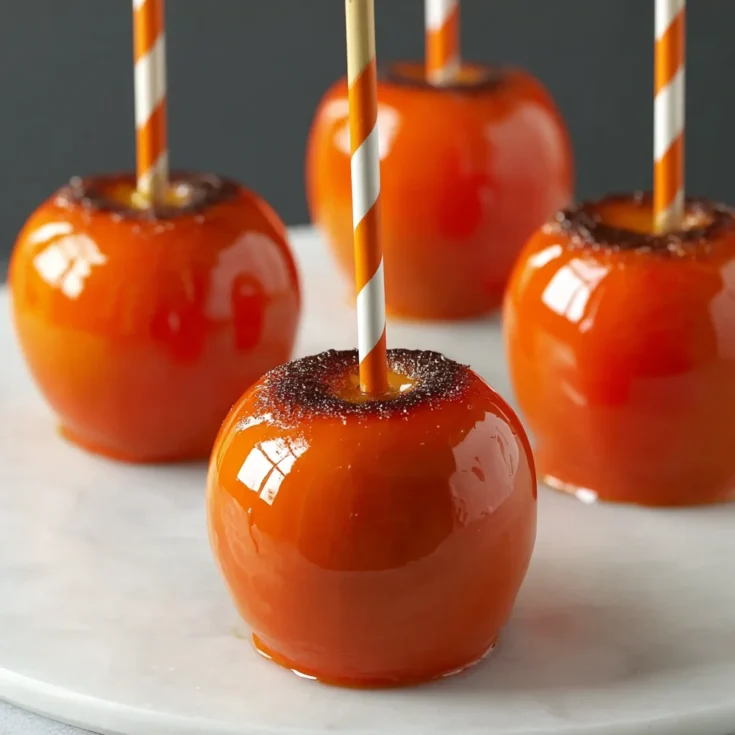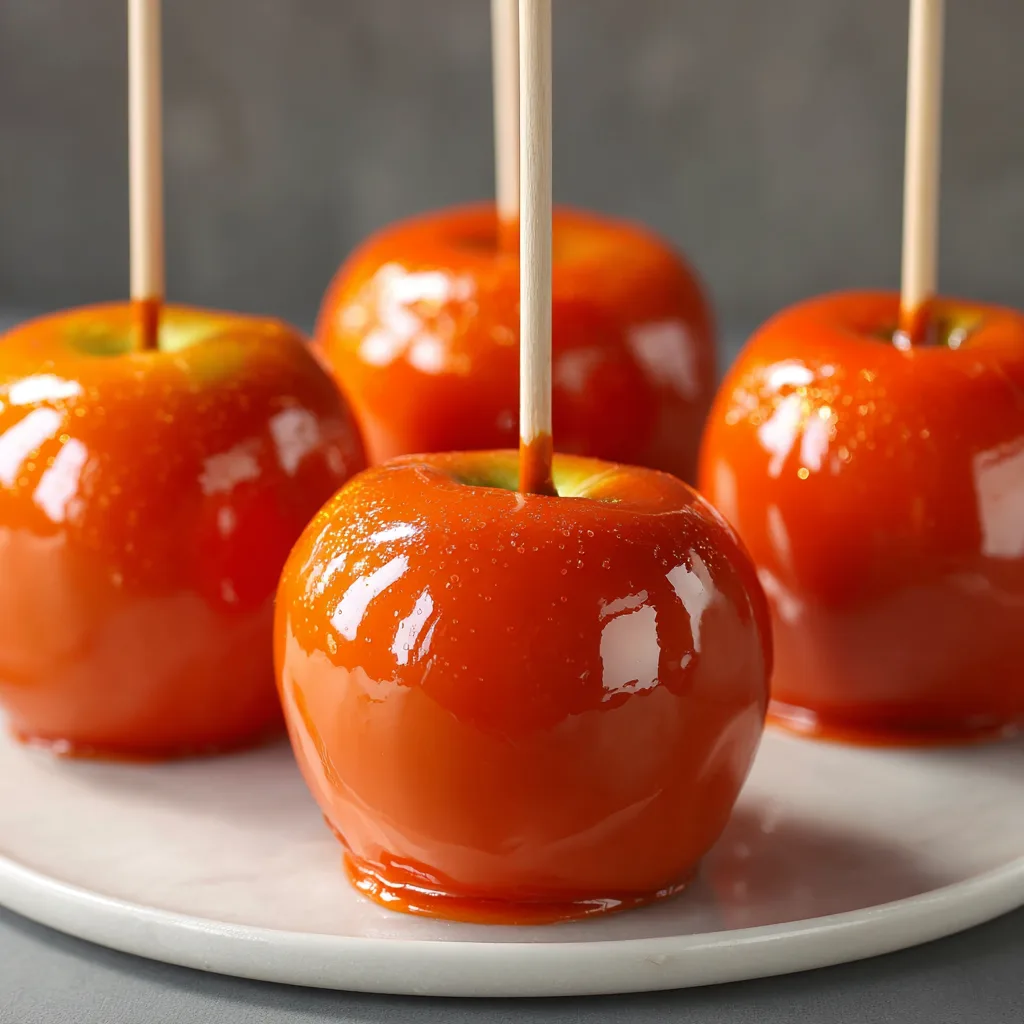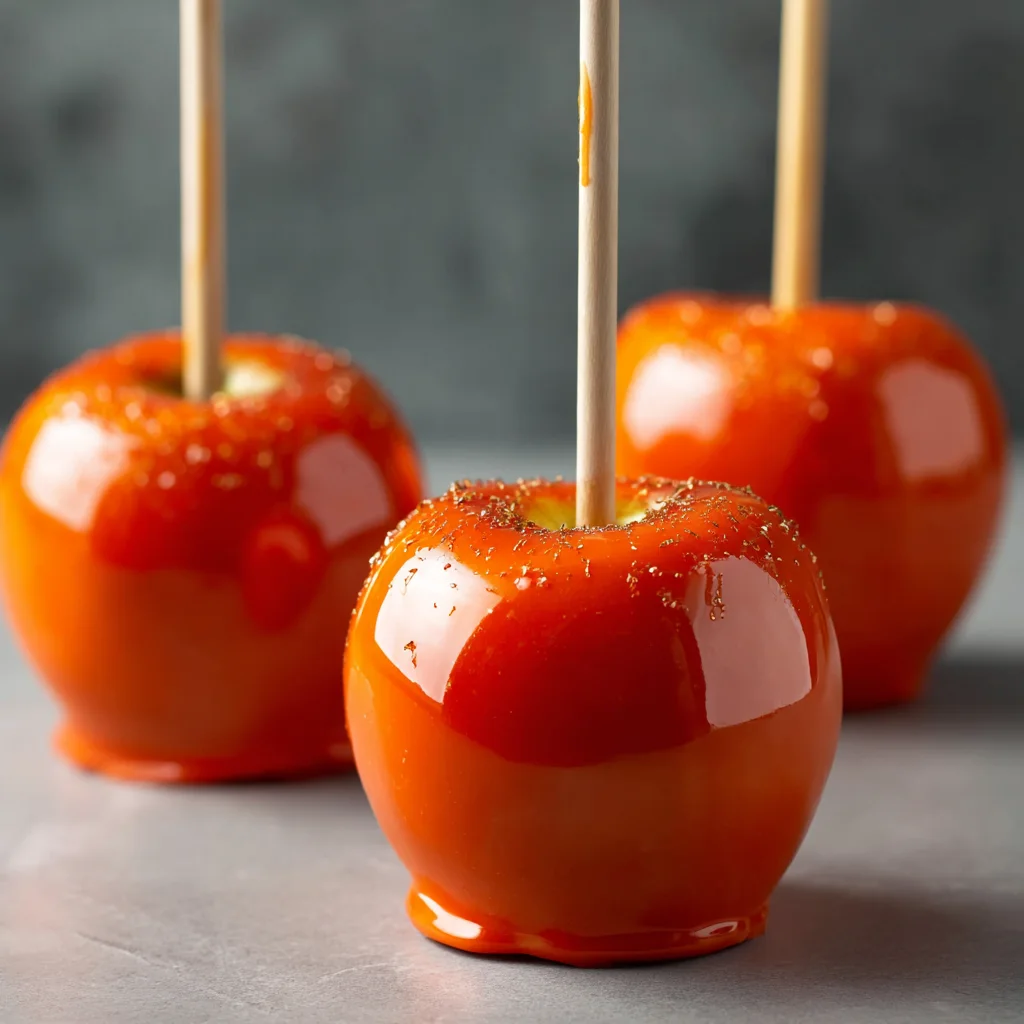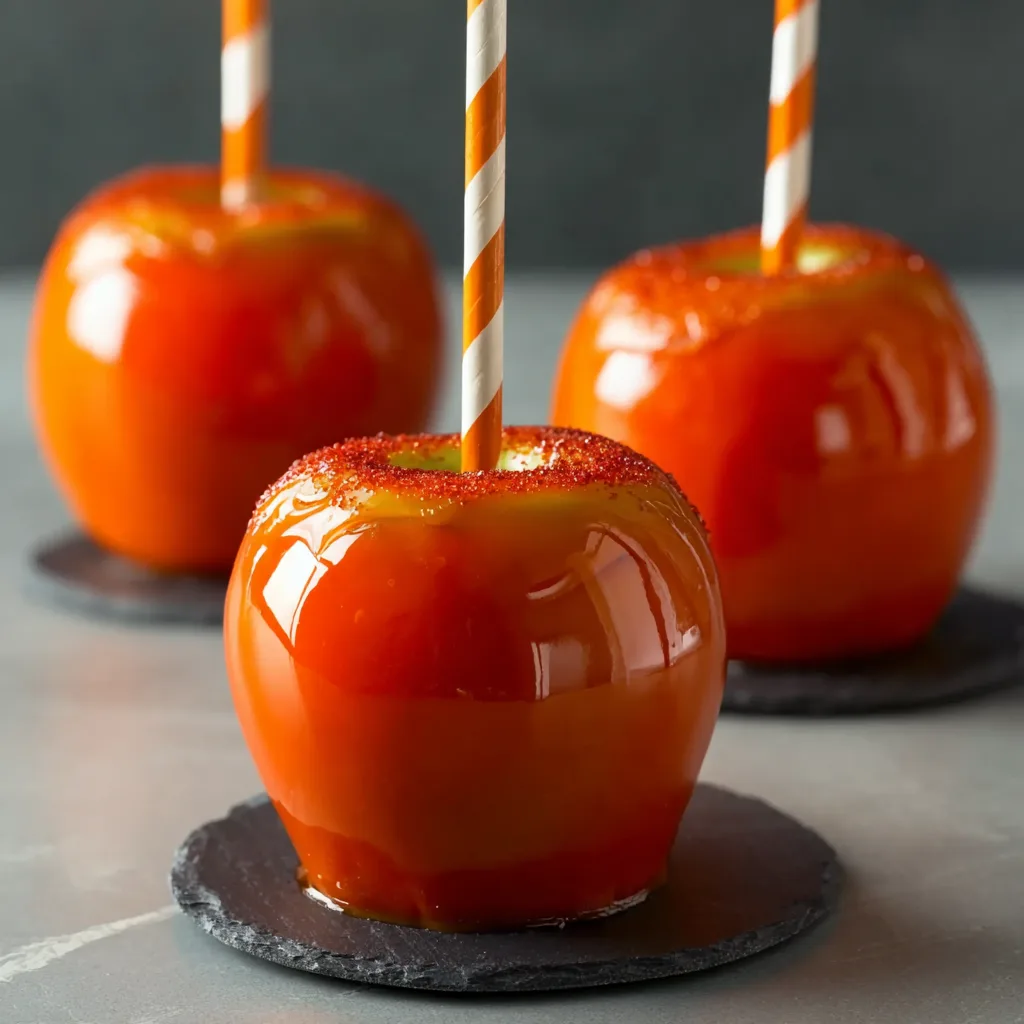The Charm of Halloween Treats
Halloween stands as one of the most eagerly anticipated holidays, especially when it comes to food. This festive occasion has a rich culinary tradition filled with sweet, spooky, and colorful treats. From pumpkin pies to candy corn, Halloween treats evoke nostalgia and joy. Among these delights, candy apples hold a special place. They combine the crisp freshness of apples with the irresistible crunch of a candy coating. These treats bring a perfect balance of sweetness and tartness, making them beloved by kids and adults alike. Their nostalgic feel and hands-on preparation make candy apples a standout choice for festive celebrations. Every bite captures the spirit of Halloween, making the holiday even sweeter.
Why Choose Orange?
Orange is the quintessential color of Halloween, symbolizing warmth, harvest, and the glowing light of jack-o’-lanterns. This vibrant hue naturally draws attention and enhances the festive atmosphere. Choosing orange for candy apples taps into this cultural symbolism, instantly making the treat feel seasonal and exciting. Visually, orange candy apples pop against dark backgrounds and autumnal décor, creating a striking display. Their bright color not only invites indulgence but also adds a playful twist to traditional candy apples. This visual appeal makes orange candy apples a popular choice for Halloween parties, trick-or-treat gatherings, and seasonal displays, perfectly blending taste with eye-catching presentation.
What Are Candy Apples?
Candy apples are a classic Halloween treat that combines fresh apples with a hard, glossy sugar coating. Unlike caramel apples, which use a soft, chewy caramel layer, candy apples feature a crisp candy shell that cracks delightfully when bitten. The candy coating usually consists of sugar, corn syrup, water, and food coloring, heated until it reaches the “hard crack” stage. This creates a shiny, brittle surface that seals the apple’s natural tartness inside. The contrast between the juicy, crisp apple and the crunchy candy shell defines the candy apple experience. This treat is not only delicious but visually appealing, making it a staple at fall festivals and Halloween parties.
Candy Apples vs. Caramel Apples
Though both candy and caramel apples center around coated apples, their taste and texture set them apart. Candy apples boast a hard, brittle exterior that shatters upon biting, offering a sweet, sugary crunch. Caramel apples, by contrast, feature a soft and chewy caramel layer that envelops the apple in a rich, buttery sweetness. The candy coating tends to be brighter and shinier, often dyed with vivid colors like the festive orange popular for Halloween. Meanwhile, caramel coatings provide a more natural, golden brown hue. Flavor-wise, candy apples are primarily sugary and sweet, with a hint of tartness from the apple, while caramel apples deliver a deeper, buttery flavor with caramel’s signature richness. Each appeals to different preferences but shares the common delight of combining fresh fruit with a sugary coating.
History and Origin
Candy apples trace their origins back to early 20th-century America. Legend credits the invention to a candy maker who accidentally spilled molten sugar on an apple and discovered the delicious results. This treat quickly grew in popularity, especially during Halloween and county fairs. The bright, glossy candy shell and the convenience of a handheld snack made candy apples a hit among children and adults alike. Over time, recipes have evolved to include various flavors, colors, and decorative touches. From classic red candy apples to seasonal variations like orange for Halloween, the treat has become a symbol of festive autumn celebrations. Its enduring appeal lies in its combination of simplicity, flavor, and nostalgic charm that continues to delight each Halloween season.
Step-by-Step Guide to Making Orange Candy Apples
Selecting the Right Apples
Choosing the right apples sets the foundation for perfect candy apples. Crisp, firm varieties work best, as they hold up well under the hot candy coating and provide a satisfying crunch. Popular choices include Granny Smith, Honeycrisp, and Fuji apples. Granny Smith apples offer a tart flavor that balances the sweetness of the candy shell, while Honeycrisp and Fuji provide a sweeter, juicier bite. Freshness is critical; apples should feel firm and heavy for their size, with no bruises or soft spots. Fresh apples ensure the candy coating adheres well and that the final treat stays crisp and enjoyable.
Preparing the Apples
Before coating, proper apple preparation is essential. Start by washing the apples thoroughly to remove any wax or residue that could prevent the candy from sticking. Use warm water and mild soap, then rinse well. After washing, dry the apples completely with a clean towel and allow them to air dry for several minutes. Moisture is the enemy of candy coating, so ensure apples are bone dry before proceeding. Next, insert sturdy wooden sticks or skewers firmly into the stem end of each apple. This makes handling easier and allows for an even dip. Make sure sticks are secure to prevent slipping during dipping.
Preparing the Candy Coating
The candy coating forms the heart of orange candy apples. You’ll need granulated sugar, light corn syrup, water, and orange food coloring to achieve that perfect festive look. Combine sugar, corn syrup, and water in a heavy saucepan over medium heat. Stir gently until the sugar dissolves. Then, increase the heat without stirring and allow the mixture to boil until it reaches the hard crack stage, approximately 300°F (149°C) on a candy thermometer. This precise temperature is key for a hard, glossy coating that cracks when bitten. Remove the pan from heat immediately to prevent burning. Quickly stir in the orange food coloring for a vibrant finish. To achieve a smooth, bubble-free coating, avoid stirring during boiling and skim off any foam or bubbles that form on the surface.
Dipping and Decorating
With the candy syrup ready and apples prepared, it’s time to dip. Hold each apple by its stick and submerge it completely into the hot candy mixture. Rotate the apple to coat evenly and lift it out carefully, allowing excess syrup to drip back into the pot. Place dipped apples on a parchment-lined baking sheet to cool and harden. For a festive touch, decorate the apples while the coating is still tacky. Popular options include colorful sprinkles, edible glitter, or even candy eyes to create fun Halloween characters. These decorations add texture, personality, and visual interest. Allow the coating to cool completely at room temperature before serving or packaging. Proper cooling ensures a crisp candy shell that delivers the satisfying crunch everyone loves.
Elevating Your Orange Candy Apples
Themed Halloween Decorations for Candy Apples
Transforming orange candy apples into festive Halloween masterpieces is easier than you might think. Start by creating spooky faces using edible markers or small candy pieces. Candy eyes, black licorice strips, or mini chocolate chips work perfectly for monster eyes, mouths, and fangs. For a creepy spider web effect, use melted white chocolate or icing to pipe delicate web patterns over the candy shell. You can also add gummy worms or candy spiders to the apple sticks to boost the creepy-crawly vibe. These simple yet creative touches turn ordinary candy apples into fun, interactive treats that excite kids and guests at any Halloween party.
Flavor Enhancements to Boost Candy Coating
Adding subtle flavors to your candy coating can elevate the taste profile and create unique twists on the classic candy apple. Incorporate ground cinnamon or a pinch of pumpkin spice into the sugar mixture for a warm, autumn-inspired flavor. A few drops of vanilla extract stirred in after removing the syrup from heat add a smooth, comforting note. For those who enjoy a little zing, a dash of ground ginger or nutmeg can complement the apple’s natural tartness beautifully. These flavor variations keep the candy apples exciting and perfectly seasonal without complicating the recipe.
Alternative Coatings for Variety
While the traditional hard candy shell is iconic, experimenting with alternative coatings can introduce new textures and flavors to your candy apples. Chocolate coatings, such as milk, dark, or white chocolate, provide a creamy, rich contrast to the crisp apple inside. For an extra festive touch, dip the chocolate-coated apples into crushed nuts, colored sugar, or candy sprinkles. Caramel coatings remain a timeless favorite, offering a soft, buttery layer that pairs beautifully with apple tartness. You can also combine coatings by dipping apples first in caramel, then in chocolate, for a layered effect. These alternatives invite creativity and satisfy diverse taste preferences while maintaining the festive spirit.
Ensuring Success with Your Candy Apples
Common Issues and How to Fix Them
Making candy apples can sometimes bring challenges, but most problems have simple solutions. If your candy coating turns sticky or soft, it often means the syrup didn’t reach the correct temperature. Use a reliable candy thermometer to ensure the mixture hits 300°F (hard crack stage). Sticky coatings can also result from moisture—make sure your apples are completely dry before dipping. Uneven dips occur when the candy cools too quickly or if apples aren’t rotated properly while dipping. To avoid this, work swiftly and evenly coat each apple by rotating slowly. If bubbles appear in the candy, skim them off before dipping to keep the surface smooth and glossy. Following these tips helps achieve the perfect crisp candy shell every time.
Storing Candy Apples and Their Shelf Life
Proper storage extends the freshness and crunch of candy apples. After the candy coating hardens completely, store apples in a cool, dry place. Avoid refrigerating them, as moisture can cause the candy shell to become sticky or dissolve. Instead, keep them at room temperature, covered loosely with plastic wrap or stored in an airtight container to prevent exposure to humidity. Candy apples are best enjoyed within three days of preparation. Over time, the candy coating may soften, and the apple inside can lose its crispness. For longer-lasting treats, prepare apples closer to the event date or store them individually wrapped to maintain their texture.
Creative Serving Suggestions for Candy Apples
Candy apples are not only tasty but also eye-catching additions to any Halloween party table. Present them standing upright in a decorated box or a foam block covered with colored tissue paper for easy access. Arrange apples on a tiered dessert stand to create a festive centerpiece. You can also tie themed ribbons or small tags to each stick, personalizing them for guests or party favors. For an interactive twist, set up a DIY candy apple decorating station where guests can add their own sprinkles and toppings. These creative serving ideas make candy apples the highlight of your celebration and enhance the overall Halloween experience.
FAQs About Halloween Orange Candy Apples
Can I use other apple varieties?
Yes! While Granny Smith apples are popular for their tartness and firmness, other crisp varieties like Honeycrisp, Fuji, or Pink Lady also work well. Choose apples that are fresh and firm to ensure the candy coating sticks and the apple stays crunchy.
How can I prevent the candy coating from bubbling?
To avoid bubbles, make sure to stir the sugar mixture gently and only until the sugar dissolves. Once boiling, do not stir. Skim off any foam that forms on top. Also, ensure the apples are completely dry before dipping, as moisture causes bubbling.
Can I make candy apples in advance?
Candy apples are best made the same day you plan to serve them. However, you can prepare them a few hours ahead and store them in a cool, dry place. Avoid refrigerating, as humidity softens the candy shell. Consume within 2–3 days for optimal taste and texture.
Are there vegan or sugar-free alternatives?
Yes. For vegan candy apples, ensure your corn syrup is vegan-friendly and avoid any animal-derived decorations. Sugar-free candy coatings can be made using sugar substitutes like erythritol, but achieving the same hard crack texture may be tricky. Experiment with recipes specifically designed for sugar-free candy coatings for best results.
Halloween Orange Candy Apples – Festive, Sweet, and Easy Treats

A festive and sweet treat combining crisp apples with a crunchy orange candy coating, perfect for Halloween celebrations.
Ingredients
- 8 medium-sized Granny Smith apples
- 2 cups granulated sugar
- ½ cup light corn syrup
- ¾ cup water
- 1 teaspoon orange gel food coloring
- 8 wooden sticks or skewers
- Optional: sprinkles, edible glitter, candy eyes
Instructions
Notes




